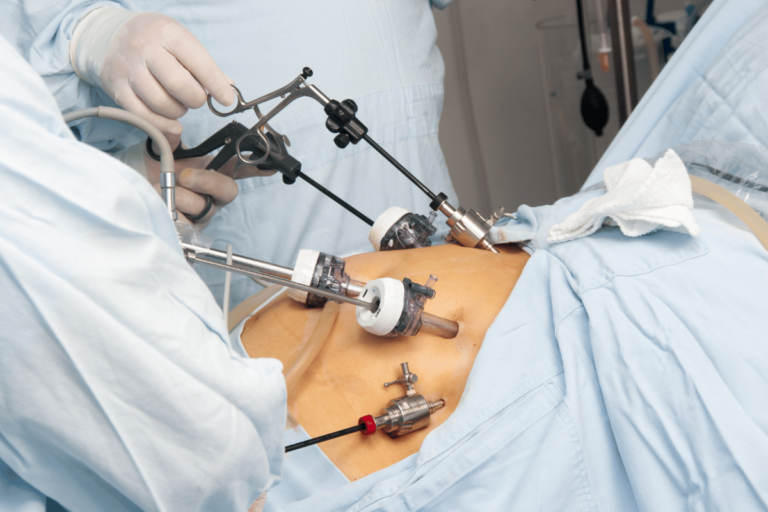Neurosurgical Advances Review: Navigating the Brain With Precision
Explore the domain of neurosurgical advancements that enhance precision in brain procedures. From minimally invasive techniques to stereotactic radiosurgery, discover the innovation shaping modern neurosurgery. Embrace robotic-assisted surgical tools for enhanced control and delve into the world of precision medicine tailored to individual needs. With advancements in imaging technology and navigation systems, witness the evolution of accurate and efficient surgical interventions. Discover the potential of neuromodulation therapies and the promising integration of artificial intelligence in neurosurgery. The intricate landscape of neurosurgical advances awaits your exploration, offering a glimpse into the future of precise brain procedures.
Key Takeaways
- Integration of advanced imaging for precise brain navigation.
- Minimally invasive techniques for enhanced precision.
- Neuromodulation therapies for targeted treatment.
- Use of AI for real-time feedback and analysis.
- Patient-centered care with tailored treatment approaches.
Evolution of Neurosurgical Techniques
The evolution of neurosurgical techniques has revolutionized the field by enhancing precision and improving patient outcomes. Over the years, there's been remarkable evolutionary progress in neurosurgery, driven by innovative surgical advancements. One key advancement is the shift from traditional open neurosurgery to minimally invasive techniques. These minimally invasive approaches involve smaller incisions, reducing the risk of complications, shortening recovery times, and improving overall patient satisfaction.
Additionally, the development of techniques such as stereotactic radiosurgery and endovascular procedures has further expanded the treatment options available to neurosurgeons. Stereotactic radiosurgery allows for precise targeting of tumors or lesions with high doses of radiation, while endovascular procedures enable the treatment of vascular conditions within the brain using catheter-based techniques.
Moreover, advancements in neuroimaging technologies have played a vital role in guiding these surgical techniques. The ability to visualize intricate brain structures with greater detail and accuracy has played a significant role in the success of modern neurosurgical procedures. By leveraging these surgical advancements alongside cutting-edge imaging technologies, neurosurgeons can navigate the brain with unprecedented precision, ultimately enhancing patient outcomes and quality of life.
Advancements in Imaging Technology
Advancements in imaging technology have revolutionized neurosurgery by providing neurosurgeons with unprecedented clarity and precision in visualizing intricate brain structures. Image guided interventions, utilizing advanced imaging modalities, have greatly enhanced surgical precision.
Novel techniques such as functional magnetic resonance imaging (fMRI) and diffusion tensor imaging (DTI) allow for real-time mapping of critical areas in the brain, minimizing the risk of damage to essential functions during surgery. These imaging modalities enable neurosurgeons to precisely target tumors or lesions with improved accuracy, leading to better patient outcomes and reduced complications.
Additionally, technologies like intraoperative CT scans and intraoperative MRI scans offer the advantage of updating surgical plans during the procedure based on real-time imaging data. The integration of these cutting-edge imaging technologies into neurosurgical practice has marked a transformative shift towards more precise, personalized, and effective treatments for various neurological conditions.
Robotic-Assisted Surgical Innovations
Incorporating robotic assistance into neurosurgical procedures enhances precision and control, revolutionizing the field with cutting-edge technology. Robotic precision plays a crucial role in improving surgical outcomes by enabling surgeons to perform complex procedures with unparalleled accuracy. The impact of this innovation on patient safety is profound, as robotic systems allow for minimally invasive techniques, reducing the risk of complications and improving recovery times.
Robotic-assisted surgical innovations have transformed the landscape of neurosurgery by providing surgeons with advanced tools that offer a high degree of dexterity and flexibility. These robotic systems can navigate intricate brain structures with remarkable precision, allowing for targeted interventions with minimal disruption to surrounding tissues. As a result, patients benefit from more precise procedures, leading to better outcomes and reduced post-operative risks.
The integration of robotics into neurosurgical practice represents a significant leap forward in the quest for excellent patient care. By harnessing the power of robotic technology, surgeons can achieve unprecedented levels of accuracy and control, ultimately enhancing the quality of care and advancing the field of neurosurgery.
Precision Medicine in Neurosurgery
Utilizing tailored treatment approaches based on individual genetic profiles, precision medicine in neurosurgery optimizes patient outcomes through personalized interventions. By integrating genetic profiling into the treatment decision-making process, neurosurgeons can design personalized treatments that target the specific molecular characteristics of each patient's condition. This approach allows for more effective and precise interventions, leading to improved surgical outcomes and reduced risks.
Innovative technologies play a pivotal role in enabling precision medicine in neurosurgery. Advanced imaging techniques, such as functional MRI and diffusion tensor imaging, aid in identifying critical brain regions and mapping neural pathways with greater accuracy. Additionally, navigational systems equipped with precision targeting capabilities enhance the surgeon's ability to precisely locate and target lesions within the brain.
Minimally Invasive Procedures
Precision medicine in neurosurgery harnesses innovative minimally invasive procedures to further enhance patient outcomes and treatment precision. Endovascular procedures play an important role in treating conditions such as aneurysms or arteriovenous malformations by accessing the brain through blood vessels, reducing the need for open surgery. By using catheters and coils inserted through blood vessels, neurosurgeons can treat complex conditions with minimal trauma to surrounding tissues.
Radiosurgery techniques, like Gamma Knife or CyberKnife, deliver precise radiation to target areas within the brain. These methods are particularly effective for treating tumors or vascular malformations that aren't amenable to traditional surgical approaches. Radiosurgery allows for high doses of radiation to be delivered with submillimeter accuracy, sparing healthy brain tissue.
Minimally invasive procedures in neurosurgery offer patients shorter recovery times, reduced risk of complications, and improved outcomes. These advanced techniques continue to revolutionize the field by providing neurosurgeons with precise tools to navigate the intricate structures of the brain.
Navigation Systems for Brain Surgeries
Navigation systems for brain surgeries provide neurosurgeons with real-time, highly detailed guidance during intricate procedures. Surgical navigation has revolutionized the field by integrating cutting-edge technology into the operating room. Through the use of advanced imaging techniques and GPS-like tracking systems, these innovations enable precise localization of brain structures, enhancing surgical accuracy.
Brain mapping plays an essential role in these navigation systems, allowing surgeons to visualize the brain in three dimensions and plan the safest and most effective surgical routes. By overlaying preoperative imaging onto the patient's anatomy during surgery, neurosurgeons can navigate with unparalleled precision, avoiding critical areas and minimizing the risk of complications.
The continuous evolution of navigation technology has greatly improved patient outcomes, reducing surgical time and postoperative complications. These systems continue to push the boundaries of what's achievable in neurosurgery, empowering surgeons to perform complex procedures with confidence and accuracy. As neurosurgical innovation progresses, navigation systems remain at the forefront of enhancing surgical precision and advancing patient care.
Neuromodulation Therapies
Neuromodulation therapies encompass targeted pain relief methods and sophisticated electrical stimulation techniques.
These therapies hold promise for a wide array of potential treatment applications, including chronic pain management, movement disorders, and psychiatric conditions.
Neuromodulation techniques are at the forefront of innovation in neurosurgical interventions, offering tailored approaches to address diverse neurological challenges.
Targeted Pain Relief
Targeted pain relief through neuromodulation therapies involves the precise modulation of neural activity to alleviate pain symptoms effectively.
In the domain of pain management, targeted drug delivery plays an essential role. This method allows for the direct administration of medication to the specific site where it's needed most, minimizing systemic side effects and enhancing the therapeutic impact.
Neurostimulation therapies are another pivotal component in the treatment of chronic pain. By applying electrical impulses to targeted areas of the nervous system, these therapies can disrupt pain signals, providing relief to individuals suffering from persistent discomfort.
The utilization of advanced technologies in neuromodulation has revolutionized the field of pain management, offering tailored solutions that cater to individual needs.
Through a combination of targeted drug delivery and neurostimulation therapies, healthcare providers can now address pain symptoms with increased precision, improving the quality of life for patients dealing with chronic pain conditions.
Electrical Stimulation Techniques
Utilizing precise electrical impulses to modulate neural activity, the application of electrical stimulation techniques in neuromodulation therapies offers a pivotal approach to managing chronic pain conditions effectively. Brain mapping plays an essential role in identifying the specific neural circuits involved in pain perception. Through the use of neuromodulation techniques such as spinal cord stimulation or deep brain stimulation, clinicians can precisely target these areas to alleviate pain symptoms.
Electrical stimulation techniques involve the placement of electrodes in strategic brain regions or along the spinal cord, where abnormal neural activity is causing pain. By delivering controlled electrical impulses to these areas, the excitability of neurons can be modulated, interrupting the pain signals before they reach the brain.
Furthermore, advancements in neuroimaging technologies have enhanced the precision of these techniques, allowing for real-time monitoring and adjustments to optimize treatment outcomes. The ability to tailor the stimulation parameters based on individual responses and brain activity patterns has significantly improved the effectiveness of neuromodulation therapies in providing long-term pain relief for patients.
Potential Treatment Applications
In the domain of managing chronic pain conditions, exploring the potential treatment applications of neuromodulation therapies reveals promising avenues for effective pain relief strategies. Neuromodulation therapies, such as spinal cord stimulation and deep brain stimulation, have shown significant potential in alleviating chronic pain by modulating neural activity.
Additionally, advancements in neuromodulation techniques have paved the way for novel treatment approaches involving stem cell therapies and gene editing techniques.
Stem cell therapies offer a revolutionary method of targeting the root causes of chronic pain by regenerating damaged neural tissues or modulating immune responses that contribute to pain sensitization. Gene editing techniques, on the other hand, provide a precise tool for modifying genetic factors that influence pain perception and processing.
Artificial Intelligence in Neurosurgery
Artificial Intelligence plays a pivotal role in revolutionizing the field of neurosurgery through its advanced data analysis capabilities and decision-making algorithms. In neurosurgery, AI integration enhances surgical accuracy and improves patient outcomes through various mechanisms:
- Image Analysis: AI algorithms analyze complex imaging scans such as MRI and CT scans, assisting in precise tumor localization and identification of critical structures.
- Surgical Planning: AI aids in creating detailed surgical plans by simulating different scenarios based on patient-specific data, ensuring best approaches for each case.
- Intraoperative Guidance: AI systems provide real-time feedback during surgery, assisting neurosurgeons in maneuvering intricate brain structures with heightened precision.
Through AI integration, neurosurgeons can access augmented decision-making tools that enhance their capabilities, leading to safer procedures and better treatment outcomes for patients. The synergy between artificial intelligence and neurosurgery continues to push boundaries, setting new standards for precision and innovation in the field.
Future Trends in Brain Mapping
What emerging technologies are shaping the future landscape of brain mapping techniques? The future of brain mapping is being revolutionized by advancements in brain interfaces and neurotechnology. Brain interfaces, also known as brain-computer interfaces (BCIs), are at the forefront of this evolution. These interfaces establish direct communication pathways between the brain and external devices, enabling the exploration of brain activity with unprecedented accuracy.
Neurotechnology advancements are playing a pivotal role in enhancing brain mapping techniques. Novel imaging modalities, such as functional magnetic resonance imaging (fMRI) and magnetoencephalography (MEG), are offering higher resolution and real-time mapping capabilities. Additionally, neurostimulation techniques, like transcranial magnetic stimulation (TMS) and deep brain stimulation (DBS), are being integrated into brain mapping protocols to modulate neural activity and map functional brain networks.
The synergy between brain interfaces and neurotechnology advancements is propelling the field of brain mapping into a new era of precision and understanding. By harnessing these cutting-edge technologies, neurosurgeons and researchers can investigate further into the complexities of the brain, paving the way for innovative diagnostic and therapeutic interventions.
Patient-Centered Care in Neurosurgery
Advancements in brain mapping techniques have driven a shift towards patient-centered care in neurosurgery, emphasizing individualized treatment approaches tailored to the unique needs and preferences of each patient. This approach focuses on enhancing patient satisfaction and outcomes through effective communication strategies.
- Enhanced Patient Satisfaction: By involving patients in decision-making processes and considering their preferences, neurosurgeons can improve overall satisfaction levels.
- Tailored Treatment Plans: Creating personalized treatment plans based on individual patient characteristics leads to better outcomes and higher patient satisfaction.
- Improved Communication Strategies: Clear and effective communication between healthcare providers and patients is essential for ensuring understanding, managing expectations, and ultimately enhancing patient satisfaction.
Patient-centered care in neurosurgery not only improves patient outcomes but also fosters a sense of empowerment and trust in the healthcare provider. By prioritizing individual needs and preferences, neurosurgeons can deliver more effective and satisfying treatment experiences for their patients.
Conclusion
As you reflect on the intricate web of neurological advancements, envision a surgeon skillfully maneuvering through the complex pathways of the brain with robotic precision.
Picture the convergence of cutting-edge imaging technology, artificial intelligence, and personalized medicine working in harmony to provide excellent patient outcomes.
The future of neurosurgery is a tapestry of innovation and compassion, where each delicate incision leads to a brighter tomorrow for those in need of neurological care.







